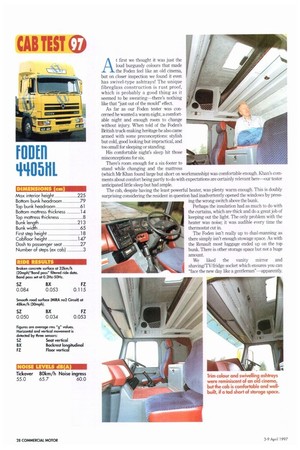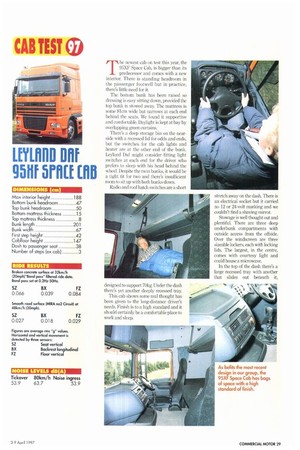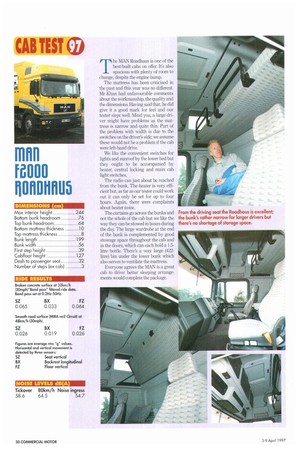A t first we thought it was just the loud burgundy
Page 30

Page 31

Page 32

Page 33

If you've noticed an error in this article please click here to report it so we can fix it.
colours that made the Foden feel like an old cinema, but on closer inspection we found it even has swivel-type ashtrays! The unique fibreglass construction is rust proof, which is probably a good thing as it seemed to be sweating—there's nothing like that "just out of the mould" effect.
As far as our Foden tester was concerned he wanted a warm night, a comfortable night and enough room to change without injury. When told of the Foden's British truck-making heritage he also came armed with some preconceptions; stylish but cold, good looking but impractical, and too small for sleeping or standing.
His comfortable night's sleep hit those misconceptions for six.
There's room enough for a six-footer to stand while changing and the mattress (which Mr Khan found large but short on workmanship) was comfortable enough. Khan's comments about comfort being partly to do with expectations are certainly relevant here—our tester anticipated little sleep but had ample.
The cab, despite having the least powerful heater, was plenty warm enough. This is doubly surprising considering the resident in question had inadvertently opened the windows by pressing the wrong switch above the bunk.
Perhaps the insulation had as much to do with the curtains, which are thick and do a great job of keeping out the light. The only problem with the heater was noise; it was audible every time the thermostat cut in.
The Foden isn't really up to dual-manning as there simply isn't enough stowage space. As with the Renault most luggage ended up on the top bunk. There is other storage space but not a huge amount.
We liked the vanity mirror and shaving/TV/fridge socket which ensures you can "face the new day like a gentleman"—apparently. The newest cab on test this year, the 95XF Space Cab, is bigger than its predecessor and comes with a new interior. There is standing headroom in the passenger footwell but in practice, there's little need for it.
The bottom bunk has been raised so dressing is easy sitting down, provided the top bunk is stowed away. The mattress is some 81cm wide but narrows at each end behind the seats. We found it supportive and comfortable. Daylight is kept at bay by overlapping green curtains.
There's a deep storage bin on the nearside with a recessed lid for odds and ends, but the switches for the cab lights and heater are at the other end of the bunk. Leyland Daf might consider fitting light switches at each end for the driver who prefers to sleep with his head behind the wheel. Despite the twin bunks, it would be a tight tit for two and there's insufficient room to sit up with both bunks down.
Radio and roof hatch switches are a short stretch away on the dash. There is an electrical socket but it carried no 12 or 24-volt marking and we couldn't find a shaving mirror.
Stowage is well thought out and plentiful. Them are three deep underbunk compartments with outside access from the offside. Over the windscreen are three sizeable lockers, each with locking lids. The largest, in the centre, comes with courtesy light and could house a microwave.
In the top of the dash there's a large recessed tray with another that slides out beneath it,
The MAN Roadhaus is one of the best-built cabs on offer. It's also spacious with plenty of room to change, despite the engine hump.
The mattress has been criticised in the past and this year was no different. Mr Khan had unfavourable comments about the workmanship, the quality and the dimensions. Having said that, he did give it a good mark for feel and our tester slept well. Mind you, a large driver might have problems as the mattress is narrow and quite thin. Part of the problem with width is due to the switches on the driver's side; we assume these would not he a problem if the cab were left-hand drive.
We like the convenient switches for lights and sunroof by the lower bed but they ought to be accompanied by heater, central locking and main cab light switches.
The radio can just about be reached from the hunk. The heater is very efficient but, as far as our tester could work out it can only be set for up to four hours Again, there were complaints about heater noise.
The curtains go across the hunks and not the whole of the cab but we like the way they can be stowed in boxes during the day. The large wardrobe at the end of the bunk is complemented by good stowage space throughout the cab and in the doors, which can each hold a 1.5litre bottle. There's a very large (422. litre) bin under the lower bunk which also serves to ventilate the mattress.
Everyone agrees the MAN is a great cab to drive: better sleeping arrangements would complete the package.
After a substantial climb to the Mercedes' cab—up five steps, no less—you find a large, airy space which is used exceptionally well.
The first surprise is the console built into the side of the all-electric, hyper-adjustable driver's seat. The Telligent gearlever is not obvious, but press a button and it whirs up into place, or disappears for crosscab access.
The flat floor means you can stand anywhere. The hunk is split into three sections—each lifts up on a gas strut—and pulls out from the wall for a little more shoulder space. We had our doubts about the split mattress but it turned out very comfortable and our tester slept just fine.
A centre console would've been handy and it's there if you look. Two lockers under the bunk roll smoothly forward into place, looking like Daleks.
The driver's-side Dalek has cupholders, pen-holders, bottle-holders, a 1211 socket and a clipboard which pops out to disclose a deep cool box. The other Dalek has a wipe-clean sandwich-box and a deep food locker.
Either can be used as a step to the top bunk: this is the same size as the bottom bunk, and is held up by more gas-struts. Again it can be made wider, and there's a nifty U-frame with a cargo net—this keeps most things secure, it's robust and it folds away without fiddly poppers or catches. Two more lockers under the lower bunk are each large enough for a driver's bedding and clothes. There's also a nylon hanging wardrobe, and the grab-handle above the passenger's door doubles as a hanger rail. The curtains are straightforward, but not completely lightproof. The locker above the windscreen is wide but shallow, as is the high-level shelving The featureless dashboard conceals two enormous ashtrays, and a pop-out radio which is convenient on the move.
Interior lighting is excellent, switched from the gear-lever console. Our night heater was a conventional Eberspacher rather than the standard integral Mercedes model, but worked well enough. The upholstery is a garish mixture of purple, malachite, coral and bleurrgh-coloured draton... but it looks durable. The mouldings are plasticky, too, but very solid: in all, it's a good-quality interior with masses of room and practicality.




































































































